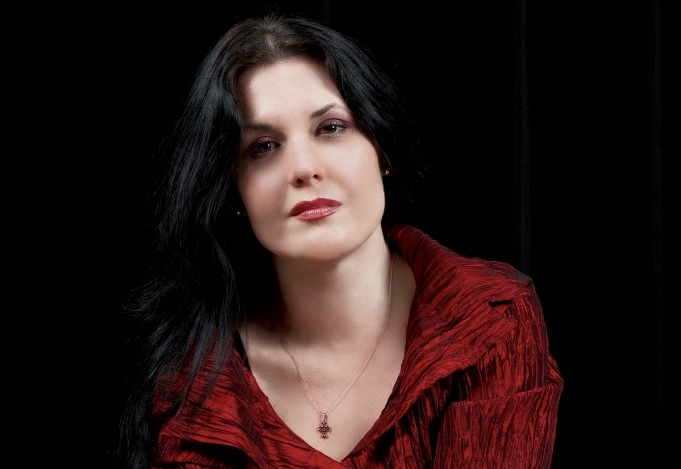Stirbat lives up to expectations with fiery debut at Miami Piano Festival
Many pianists open recitals with a bit of Haydn or Mozart, loosening up their fingers with a technically undemanding nod to the Classical period.
Not the Romanian virtuoso Raluca Stirbat, who made her U.S. debut Friday in Miami Beach as part of the Miami International Piano Festival.
Stirbat plunged immediately into Romantic fireworks and drama, beginning her recital at the Colony Theater with Liszt’s Mephisto Waltz No. 1—a real workout for the pianist that she took at diabolical speed. If she hit a few wrong notes in all the pounding octaves and chords, that was the price of this sort of fearless, committed performance.
And there was much more to the performance than just floor-shaking, virtuoso display—her playing of the soft, voluptuous middle theme came off with a dark sensuality, perfectly capturing the spirit of the work.
Liszt’s Sonata in B Minor is one of the great monuments of the piano repertory, big, sprawling and heroic. Stirbat played it with great depth of concentration, at times with the improvisatory feel of a concerto cadenza. Yet she maintained taut control over its many elements, with a firm sense of its dramatic high points. The majestic, chorale-like fourth theme came off with orchestral grandeur, and each time it returned it was different, once nostalgic, another time with a latent power that quickly became manifest.
Her right hand played with the sort of fleet agility that lends much of the sparkle to Liszt’s piano music, and she had a way with his long lines of sensuous melody that contrast with both the passages of chaste, religious awe and sinister malice. She also emphasized the growling, darker themes in the bass, playing with an almost savage power that made the moments of light and nobility that much more effective.
The music of the 20th-century Romanian composer Mihail Jora is rarely heard in the United States, and Stirbat took a step toward remedying that with a performance of his Joujoux pour Ma Dame (Five Pieces for piano). Although we may expect composers to produce works that sound like the music we imagine from their homelands, there was nothing that seemed particularly nationalistic about this music. If anything, it sounded like early 20th- century French music, an even more harmonically adventurous Ravel. These very short pieces painted different moods–dreamy, turbulent, rhythmically witty–all rendered by Stirbat with a wide palette of colors.
Stirbat is a great champion of the music of George Enescu, the great 20th-century Romanian violinist, teacher and composer. She is just finishing a recorded set of his complete piano music, is working on a PhD thesis on his piano works, founded the George Enescu Society in 2011 and has launched a campaign to preserve his house in Mihăileni, Romania.
She performed his Piano Sonata No. 3, a work that would surprise anyone who knows Enescu primarily through his famous Romanian Rhapsody No. 1 for orchestra. In contrast to the Rhapsody‘s folk tunes and gypsy-tinged violin passages, there was little obviously nationalistic in the sonata, aside from a few turns of phrase in the slow movement.
The sunny first movement was all light textures and fleet fingerwork, performed by Stirbat with agility and a touch of humor. The Andantino had a meditative, improvisatory tone, perhaps reminiscent of the Gypsy violinists Enescu heard in his youth. Stirbat brought out its wistful, autumnal quality, playing the repeated motifs and scraps of melody as if she was composing on stage. The concluding Allegro returned to the quick, light textures of the first movement, with simple repetitive motifs that passed from mood to mood in Stirbat’s evocative interpretation—lighthearted, hard-driving, dark and eerie—then growing in complexity in power, with Stirbat generating an almost imperceptible crescendo to work’s clanging ending.
Ravel’s arrangement for solo piano of his La Valse for orchestra is an extremely difficult work. Yet what was striking about Stirbat’s performance was less her surmounting of the technical challenges than the suppleness and flexibility with which she brought to life the composer’s weird take on the classic dance. The waltz would crank up, grind to a stop, start up again, only to be obliterated by a brutal little bass motif—all brought out by Stirbat as her hands flew around the keyboard in this intricate music.
The small but highly enthusiastic audience gave her a standing ovation and she responded with two encores. First came Constantin Silvestri’s Baccanale, a mini-hurricane of a piece that had her hands flying over the keyboard. And finally more Liszt, the Consolation No. 3, a songlike respite from the previous keyboard heroics, played with sensitivity and lyricism.
The Miami International Piano Festival continues 7:45 p.m. Saturday at the Colony Theater in Miami Beach with pianist Leonid Egorov in works of Chopin, Scriabin, Debussy, Beethoven, Mozart, Liszt, Mahler, Rachmaninoff and Busoni. miamipianofest.com; 305-434-7091.
Posted in Performances
Leave a Comment
Sat May 16, 2015
at 2:24 pm
No Comments
